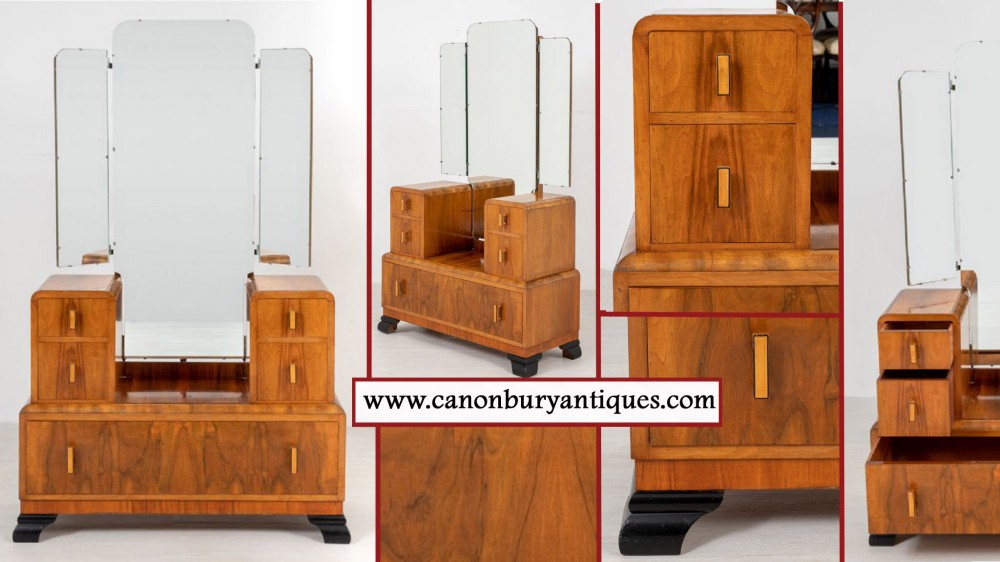What was the Style of Furniture in the 1920s: Iconic Designs
Are you curious about the intriguing world of 1920s furniture design? Imagine stepping into a space where elegance meets innovation, where each piece tells a story of a time when the world was rapidly changing.
The 1920s was a remarkable era for furniture, marked by a blend of styles that reflected both tradition and modernity. As you explore this fascinating period, you’ll discover how Art Deco, Bauhaus, and other design movements influenced the furniture that graced the homes of that decade.
By understanding these styles, you can gain insights into how furniture can transform a space and perhaps find inspiration for your own home. Dive into the past and see how the designs of yesterday can influence the trends of today.
Art Deco Influence
The 1920s was a dynamic era for furniture design. The Art Deco movement emerged as a defining style. This aesthetic captivated many with its bold and modern approach. Art Deco furniture was a symbol of elegance and sophistication. It represented luxury and innovation in design. Furniture from this period showcased vibrant colors and unique patterns. The influence of Art Deco remains evident in the world of interior design today.
Geometric Shapes
Art Deco furniture often featured strong geometric shapes. Designers favored angular lines and symmetrical forms. These shapes created a sense of order and balance. Bold patterns were common in furniture designs. Diamonds, zigzags, and chevrons were popular motifs. These geometric elements added visual interest and energy. They made furniture pieces stand out in any room. The clean lines of Art Deco furniture complemented modern interiors.
Luxurious Materials
Art Deco embraced the use of luxurious materials. Designers used exotic woods like ebony and mahogany. Metals like chrome and brass added shine and glamor. High-quality fabrics such as silk and velvet were often seen. Furniture pieces featured inlays of ivory and mother-of-pearl. These materials spoke of wealth and elegance. They were chosen to impress and convey opulence. The craftsmanship of Art Deco furniture was exceptional. Each piece was designed to be both beautiful and functional.
Bauhaus Movement
The Bauhaus Movement in the 1920s introduced sleek furniture designs. Geometric shapes and clean lines dominated, focusing on functionality. Materials like steel and leather became popular, creating an innovative modern look. This style emphasized simplicity and practicality, aligning with the movement’s vision of merging art and industry.
The 1920s witnessed a significant shift in furniture design. The Bauhaus Movement emerged as a leading force. It combined art with industrial design. This movement focused on creating furniture that was both practical and artistic. The Bauhaus school in Germany played a major role. It influenced furniture styles worldwide. This movement emphasized simplicity and functionality. These principles became core aspects of modern design.Functional Design
The Bauhaus Movement prioritized functional design. Furniture pieces were created with purpose. Designers aimed to maximize utility. Every piece served a specific function. Chairs, tables, and shelves were straightforward and practical. Bauhaus designers often used new materials. Steel, glass, and plywood became popular choices. These materials supported the movement’s functional goals.Minimalist Aesthetic
The minimalist aesthetic defined Bauhaus furniture. Designs were free from unnecessary details. Clean lines and simple forms were common. This minimalist approach appealed to many. It offered a break from ornate styles of the past. Bauhaus pieces often had a sleek and modern look. The focus was on form and function. This simplicity made Bauhaus furniture timeless and elegant.Modernism Emergence
In the 1920s, furniture styles saw a remarkable shift. The era marked the emergence of modernism, a movement that embraced simplicity and functionality. Designers started to reject ornate details and opted for clean lines. This change reflected a broader societal move towards modernity. Homes began to mirror the rapid progress happening in the world.
Innovative Techniques
Craftsmen in the 1920s experimented with new materials. Steel, glass, and plywood became popular choices. These materials allowed for sleek, elegant designs. Furniture makers embraced mass production. This made stylish pieces more accessible to the public. Machines played a vital role in shaping new furniture forms. The use of innovative techniques led to unique, modern designs.
Focus On Comfort
The modernism movement placed a strong emphasis on comfort. Designers sought to create furniture that was both practical and cozy. Upholstered chairs and sofas became common in living rooms. Ergonomic designs aimed to enhance user comfort. The focus was on creating a balance between form and function. People wanted furniture that suited their daily needs. Comfort was no longer a luxury but a necessity in design.
Credit: www.businessinsider.com
Exotic Themes
The 1920s were a time of exploration and discovery. This spirit extended to furniture design. Exotic themes became popular, adding unique flair to homes. Designers drew inspiration from faraway lands, creating captivating pieces. These pieces brought a sense of adventure indoors. The furniture showcased a blend of cultural influences. Each piece told a story of distant places and vibrant cultures.
Oriental Influence
Oriental designs enchanted the 1920s furniture scene. Rich colors and intricate patterns were common. Silk and lacquered wood were popular materials. Designs often featured dragons, birds, and flowers. These elements added elegance and mystery to furniture. Oriental screens and cabinets became fashionable. They served as both functional and decorative pieces.
African Patterns
African patterns brought boldness and vibrancy to furniture design. Geometric shapes and earthy tones were characteristic. Designers used materials like rattan and hardwood. Tribal motifs adorned many pieces, adding cultural depth. Furniture often featured animal prints and carvings. These designs offered a connection to the natural world. They brought warmth and texture to 1920s interiors.
Materials And Craftsmanship
The 1920s marked a fascinating era in furniture design, characterized by a mix of innovation and traditional craftsmanship. This decade embraced new materials and celebrated artisanal quality, reflecting the dynamic cultural shifts of the time. Understanding these elements provides insight into the unique style and elegance of 1920s furniture.
Use Of New Materials
Furniture makers in the 1920s experimented with modern materials. Metal, glass, and plastics gained popularity in designs. Chrome and steel offered sleek, shiny finishes. These materials introduced fresh, industrial aesthetics. Glass was used for tabletops and decorative features. It added a touch of sophistication and transparency. Plastics appeared in accessories and small furniture pieces. They brought vibrant colors and versatile shapes. The use of new materials changed the look of living spaces.
Artisanal Quality
Despite the rise of new materials, craftsmanship remained crucial. Skilled artisans crafted furniture with care and detail. Woodwork showed intricate carvings and fine joinery. Upholstery showcased hand-sewn patterns and rich fabrics. Craftsmen focused on durability and beauty. Handmade pieces displayed artistry and dedication. Each piece was a testament to skill and tradition. Artisanal quality added timeless charm to 1920s furniture.

Credit: study.com
Iconic Designers
The 1920s marked a transformative era in furniture design. Many designers emerged during this time, reshaping aesthetics with their unique styles. Their works remain influential, reflecting the essence of the Roaring Twenties. Among these visionaries, Eileen Gray and Le Corbusier stood out. They introduced innovative designs that still captivate furniture enthusiasts today.
Eileen Gray
Eileen Gray was a pioneering designer known for her modernist approach. She blended functionality with elegance in her creations. Her most famous piece is the Bibendum Chair. It features a bold, tubular design that was revolutionary for its time. Gray’s work often included geometric shapes and luxurious materials. She was a master of using lacquer and chrome in her designs. Her furniture pieces remain timeless and are celebrated for their innovative style.
Le Corbusier
Le Corbusier was a giant in the world of modern architecture and design. He sought to create furniture that aligned with modern living needs. His designs emphasized simplicity and comfort, using clean lines and industrial materials. The LC4 Chaise Lounge is one of his iconic pieces. It is known for its adjustable frame and ergonomic design. Le Corbusier’s works reflect a balance of form and function. His influence extends far beyond the 1920s, shaping modern furniture design principles.
Popular Furniture Pieces
The 1920s furniture style embraced sleek lines and geometric shapes, reflecting the Art Deco movement. Rich materials like walnut and chrome added elegance, while bold colors provided a vibrant touch. This era favored a balance between modernity and sophistication, creating iconic pieces still admired today.
When you think about the 1920s, what comes to mind? Maybe the roaring jazz music or the glitz and glamour of the flapper era. But did you know that this decade also brought about some iconic furniture pieces that still inspire modern design today? Whether you’re a history buff or just love unique home decor, understanding the popular furniture pieces of the 1920s can give your living space a touch of vintage elegance.The Club Chair
The club chair emerged as a staple in the 1920s, known for its deep seats and luxurious leather upholstery. It was designed for comfort, inviting you to sink into its embrace after a long day. The rounded arms and back gave it a distinctive look that set it apart from more traditional seating options. In the 1920s, club chairs were often found in gentlemen’s clubs, hence the name. Imagine sitting in one of these classic chairs, a good book in hand, feeling like you’re part of a bygone era. Today, adding a club chair to your living room can bring that same sense of timeless style and comfort.The Chaise Longue
The chaise longue, with its elegant and elongated design, became a symbol of luxury in the 1920s. This piece was perfect for those who wanted to relax in style, offering a place to recline and unwind. The design often featured ornate details and high-quality fabric, making it a centerpiece in any room. Picture yourself stretched out on a chaise longue, a glass of lemonade by your side, the afternoon sun streaming in through the window. It was more than just a piece of furniture; it was a lifestyle choice that represented leisure and sophistication. Today, the chaise longue continues to be a popular choice for those wanting to add a touch of elegance to their homes. These pieces are not just relics of the past; they offer practical insights into how furniture can be both functional and stylish. When you choose a club chair or chaise longue for your space, you’re not just adding a piece of furniture—you’re inviting a piece of history into your home. What furniture piece from history would you love to add to your living room?
Credit: canonburyantiques.com
Frequently Asked Questions
What Characterized 1920s Furniture Design?
The 1920s furniture design was characterized by sleek lines, geometric patterns, and luxurious materials. Art Deco was the dominant style, emphasizing elegance and modernity. Popular materials included exotic woods, chrome, and glass. This era embraced bold colors and lavish embellishments, reflecting the opulence of the time.
How Did Art Deco Influence Furniture In The 1920s?
Art Deco heavily influenced 1920s furniture with its emphasis on glamour, luxury, and modernity. It featured geometric shapes, rich colors, and lavish materials like marble and ebony. Designers focused on creating bold, streamlined pieces that exuded sophistication and elegance, making it a defining style of the decade.
What Materials Were Popular In 1920s Furniture?
Popular materials in 1920s furniture included exotic woods like mahogany and walnut. Chrome, glass, and mirrors were also widely used. These materials contributed to the luxurious and modern aesthetic of the era. Designers often incorporated rich fabrics, such as velvet and leather, to enhance the opulent feel.
Were Bold Colors Used In 1920s Furniture?
Yes, bold colors were a hallmark of 1920s furniture design. Vibrant hues like deep reds, greens, and blues were commonly used. These colors added to the dramatic and opulent aesthetic of the time. Designers often paired bold colors with metallic finishes to create striking and elegant pieces.
Conclusion
Furniture from the 1920s offers a glimpse into history. Bold designs. Rich materials. The era blends elegance with practicality. Art Deco influences shine through in every piece. Sleek lines and geometric shapes dominate. Furniture was stylish, yet functional. Crafted to impress and endure.
This period reflects a unique cultural shift. Timeless and inspiring. The 1920s style remains relevant today. Explore these designs to appreciate their beauty. Discover how they shaped interior trends. Embrace the charm of vintage furniture. Let it enrich your space with history and flair.






